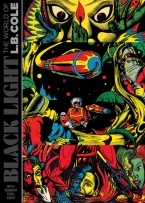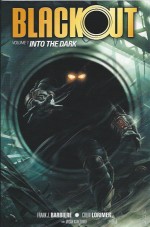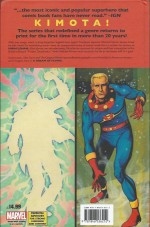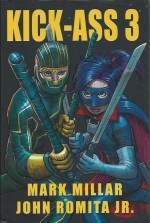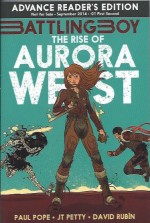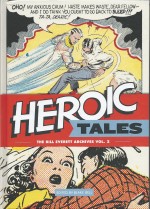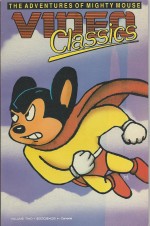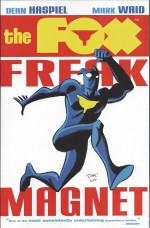
By Dean Haspiel, Mark Waid, JM DeMatteis, Mike Cavallaro, Terry Austin & various (Red Circle Comics/Archie)
ISBN: 978-1-936975-93-8
In the early days of the US comicbook biz, just after Superman and Batman had ushered in a new genre of storytelling, a rash of publishers jumped onto the bandwagon and made their own bids for cash and glory.
Many thrived and many more didn’t, relished only as trivia by sad old blokes like me. Some few made it to an amorphous middle-ground: not forgotten, but certainly not household names either…
MLJ were one of the quickest outfits to pump out a mystery-man pantheon, following the spectacular successes of the Man of Tomorrow and Darknight Detective with their own small but inspirational pantheon of gaudily clad crusaders.
Beginning in November 1939 (one month after a little game-changer entitled Marvel Comics #1) with Blue Ribbon Comics #1: content comprising the standard blend of two-fisted adventure strips, prose pieces and gag panels and, from #2 on, costumed heroes. They rapidly followed up with Top-Notch and Pep Comics. …
However, after only a few years Maurice Coyne, Louis Silberkleit and John Goldwater (hence MLJ) spotted a gap in the blossoming market and in December 1941 nudged aside their masked heroes and action strips to make room for a far less imposing hero; an “average teen†who would have ordinary adventures like the readers, but with triumphs, romance and slapstick emphasised.
Pep #22 (December 1941) featured a gap-toothed, freckle-faced, red-headed goof who took his lead from the popular Andy Hardy movies starring Mickey Rooney. Goldwater developed the concept of a youthful everyman protagonist, tasking writer Vic Bloom and artist Bob Montana with the job of making it work. The 6-page tale introduced Archie Andrews and pretty girl-next-door Betty Cooper and his unconventional best friend and confidante Jughead Jones in a small-town utopia called Riverdale.
The feature was an instant hit and by the winter of 1942 had won its own title. Archie Comics #1 was the company’s first solo-star magazine and with it began the gradual transformation of the entire company. With the introduction of rich, raven-haired Veronica Lodge, all the pieces were in play for the comicbook industry’s second Genuine Phenomenon (as influential, if not so all-pervasive, as Superman)…
By 1946 the kids had taken over, and MLJ renamed itself Archie Comics; retiring its heroic characters years before the end of the Golden Age and becoming, to all intents and purposes, a publisher of family comedies. Its success, like Superman’s, changed the content of every other publisher’s titles, and led to a multi-media industry including TV shows, movies, and a chain of restaurants. In the swinging sixties the pop hit “Sugar, Sugar†(a tune from their animated show) became a global smash: their wholesome garage band The Archies has been a fixture of the comics ever since.
Nonetheless the company had by this stage blazed through a rather impressive legion of costumed champions (such as The Shield – America’s first patriotic superhero – predating Captain America by 13 months) who would form the backbone of numerous future superhero revivals, most notably during the High-Camp/Marvel Explosion/Batman TV show-frenzied mid-60’s…
The heroes impressively resurfaced in the 1980s under the company’s Red Circle imprint but again failed to catch enough public’s attention. Archie let them lie fallow – except for occasional revivals and intermittent guest-shots in regular Archie titles – until 1991, when the company licensed its heroes to superhero specialists DC for a magically fun, all-ages iteration (and where’s that star-studded trade paperback collection, huh?!).
Impact Comics was a vibrant, engaging and fun all-ages rethink that really should have been a huge hit but was again incomprehensibly unsuccessful…
When the line folded in 1993 the characters returned to limbo until the company had one more crack at them in 2008, briefly incorporating the Mighty Crusaders & Co into DC’s own maturely angst-ridden and stridently dark continuity – with the usual overwhelming lack of success.
In 2012 the company began reinventing their superhero credentials with a series of online adventures under the aegis of a revived Red Circle subdivision, beginning with The Mighty Crusaders (reinforced by traditional monthly print versions six months later): new costumed capers emphasising fun and action which were equally welcoming to inveterate fanboys and eager newcomers alike…
One of the company’s most tantalising and oddly appealing Golden Age second stringers was a notional Batman knockoff dubbed The Fox. Debuting in Blue Ribbon #4 (June 1940), ambitious, go-getting young photojournalist Paul Patton initially dressed up as a costumed crusader to get exclusive scoops before properly catching the hero-bug.
The strip was scripted by Joe Blair and drawn by Irwin Hasen (who apparently later recycled the timelessly elegant costume design for DC/All American’s Wildcat in January 1942’s Sensation Comics #1), running until #22 – March 1943 – after which the dark detective vanished until revived as a walk-on in Mighty Crusaders #4 (April 1966).
He was particularly well-served during a subsequent 1980s revival when visual narrative genius Alex Toth illustrated many of his new adventures and now the character – or rather his son – has been singled out for solo stardom in the most recent electronic Red Circle incarnation.
This superbly riotous collection collects the first story-arc and a few cool on-line extras which were published in 2013 as the sublimely witty and engaging action-romp The Fox: Freak Magnet #1-5.
As seen in the recent New Crusaders: Rise of the Heroes, this Earth’s masked heroes were generally enjoying a well-deserved retirement in the idyllic little city of Red Circle, until they were tracked down and murdered by old foe The Brain Emperor.
Only elderly Joe Higgins was left to save their kids and heirs: shepherding them through a long-practised escape plan devised by the heroic Mighty Crusaders to safety and the eventual attainment of their true potentials as heroes in their own right…
Higgins was a lucky choice: the world’s first masked superman and a trusty Shield against all evil and injustice…
At first, all that has very little to do with Paul Patton Jr., who has voluntarily followed in his own father’s footsteps both as a photojournalist and masked mystery man for the same venal reasons only to discover that both jobs come at an inescapable price…
In his case trouble and insanity always finds him, so he might as well be dressed and ready for the occasions…
Following a Foreword by Mike Allred, the further adventures of The Fox – as imagined by plotter/artist Dean Haspiel and scripter Mark Waid – begin with ‘Freak Magnet part 1: Public Face’ as the reluctant the hero accidentally exposes the shady secret of the world’s most beautiful social media tycoon whilst on a cushy photo assignment.
The magnificent Lucy Fur seems to have everything going for her, but the Fox’s infallible gift for stumbling into unfortunate situations soon “outs†the beautiful siren as manic monster Madame Satan…
No sooner has the Roguish Reynard despatched her than he is accosted by an extradimensional princess in distress and desperately requiring a few good men in ‘Diamonds Are a Girl’s Best Friend’…
The frantic Queen of Diamonds has already shanghaied a number of Earth’s greatest champions, sending them to save her beloved husband from the wicked Druid who has transformed him into a ravening monster. Now, however, short of power – and viable options – she has finally arrived at the merely human but extraordinarily lucky Patton…
Given no chance to refuse, the fed-up Fox is soon questing through a bizarre world, enduring horrific hallucinations (including his not-so-understanding wife Mae who infrequently suits-up as the sultry She-Fox) and a succession of marauding man-things. After he defeats a particularly big beast it reverts to the battered form of missing pulp hero Bob Phantom…
That issue also began a back up serial by JM DeMatteis, Mike Cavallaro & Terry Austin.
‘Shield: The Face of Hate part 1 – A Very Cold War’ finds aged but still vital Joe Higgins in a bar recounting one of his WWII exploits…
Debuting way back when in Pep Comics #1, Higgins was an FBI scientist who devised a suit which gave him enhanced strength, speed and durability, battling the USA’s enemies as The Shield in the days before America entered WWII. He also devised a serum which enhanced those powers, smashing spies, saboteurs, subversives and every threat to Democracy and decency.
This particular old soldier’s yarn concerns a 1944 mission in Antarctica to crush an Axis super-weapon but which found him facing not just a legion of monsters but also his Nazi and Japanese counterparts Master Race and Hachiman…
Chapter three of Freak Magnet resumed with Haspiel & Waid’s lucky lad wandering through ‘Hell’s Half Acre’ like a lycra-draped Indiana Jones in Dante’s Inferno; en route defeating and curing mutated monster Inferno, the Flame Breather before rescuing gun-toting vigilante The Marvel from a macabre torture chamber.
Unfortunately, once released, the Scourge of Gangland was a little traumatised and could no longer tell friend from foe…
Meanwhile back in World War II, ‘The Face of Hate part 2 – The Enemy of My Enemy’ (DeMatteis, Cavallaro & Austin) saw the sworn enemies’ three-way battle spiral into berserker rage until a grotesque horror jumped all three of them…
In the Diamond Dimension, whilst Inferno tackled a maddened Marvel, The Fox had to face the Queen’s ensorcelled husband in ‘The Voodoo You Do’ (Haspiel & Waid) until the nigh-omnipotent Druid took a personal hand. Happily at that moment the more-or-less dutiful wives appeared, the power of love and engagement rings having allowed the Queen and Mae to cross the dimensional divide and tip the scales.
With the Druid blasted to chunks Patton thought the madness had subsided for awhile… until the Diamond Ruler blasted the Earthlings home and he arrived alone in the Antarctic, dumped into another insanely dangerous situation…
‘Shield: The Face of Hate part 3 – A Mind of Shattered Glass’ (DeMatteis, Cavallaro & Austin) saw the hate-filled human foes swallow their feelings to unite in combat against an incredible predatory horror which had grown from a fragment of a far greater being destroyed in antiquity and scattered throughout the universe.
This entity fed on hate and planned to transform Earth into a world of monsters, but just as it completed its evolution into a new, much more malign and menacing Druid, a black clad, long-eared and annoyingly familiar figure materialised…
The time-tossed twin sagas combine for the epic conclusion ‘Freak Magnet: Future’s End’ (by DeMatteis & Haspiel) as Fox, Shield, Hachiman and Master Race strive together to save humanity and find themselves forever changed by the cosmic experience…
A fulsome ‘Afterword by Dean Haspiel’ is followed by one more comics treat as the effulgent everyman crafts a delicious and hilariously thrilling short yarn starring Paul Patten Jr. and explains his choice of cameras in ‘Epilogue: A Picture Lasts Forever’…
This delightful exercise in reviving the fun-filled excitement of comics that don’t think they’re Shakespeare or Orwell also includes such extra inducements as a vast (23!) covers-&-variants gallery by Haspiel, Darwyn Cooke, Fiona Staples, Mike Norton, Allen Passalaqua, Paul Pope, Mike & Laura Allred, David Mack, Howard Chaykin, Jesus Aburto, Mike Cavallaro & Alex Toth as well as a fact-packed ‘Special Feature’ section revealing some of The Fox Files’.
Beginning with the lowdown on the cagy crusaders in ‘Origin of the Freak Magnet’ and ‘She-Fox: The Vivacious Vixen’ there is even room for bonus featurette ‘Red Circle Heroes: Extra Pulp’, offering character insights and publication histories on ‘Bob Phantom’, ‘Inferno’ and ‘The Marvel’.
And best yet, there’s a great big tantalising “To Be Continued…†page…
Full of vim and vigour, this phenomenal Will Eisner-inspired romp provides no-nonsense, outrageously emphatic superhero hijinks drenched in slick, smart, tried-&-true comicbook bombast and action which manages to feel brand-new whilst simultaneously remaining faithful to all the past iterations and re-imaginings of the assorted superheroes.
Fast, fulfilling and immediately addictive, The Fox might just be Archie’s long-awaited superhero superstar…
If you yearn for the uncomplicated fantastic Fights ‘n’ Tights furore of your youth – whenever that was – this is a book you must not miss.
THE FOX ™ and RED CIRCLE COMICS ® ACP, Inc. The individual characters; names and likenesses are the exclusive trademarks of Archie Comics Publications, Inc. © 2014 Archie Comics Publications, Inc. All rights reserved.
